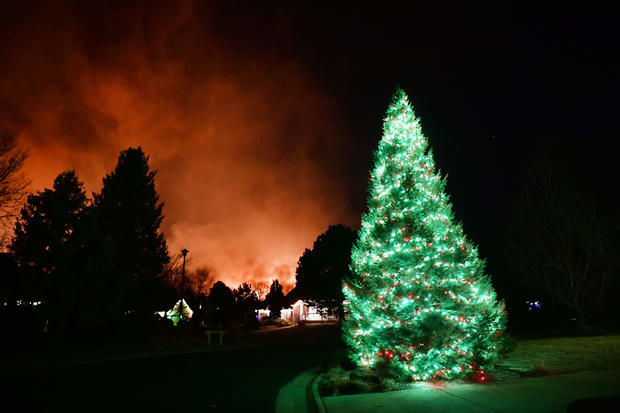Denver — Tens of thousands of residents were forced to evacuate their homes outside Denver Thursday as wildfires fueled by hurricane force winds gusting up to 105 mph engulfed parts of three cities. Nearly 600 homes were destroyed by one of them-- the #MarshallFire -- along with a hotel, shopping center and other businesses, CBS Denver reports. The fire had burned 1,600 acres and was still growing Thursday night, the station said. It pointed out that the most destructive wildfire in Colorado history was the Black Forest Fire, which chewed up more than 14,280 acres and destroyed 511 homes in 2013. CBS Denver said winds were expected to weaken considerably overnight. The National Weather Service Boulder Office tweeted that they already had calmed down quite a bit by evening: At least one first responder and six others were injured in the fires that began Thursday morning, unusually late in the year and following an extremely dry fall and a winter so far nearly devoid of snow. Boulder County Sheriff Joe Pelle acknowledged that more injuries and deaths were possible due to the intensity of fires that quickly swept across the region. "This is the kind of fire we can't fight head on," Pelle said. "We actually had deputy sheriffs and firefighters in areas that had to pull out because they just got overrun." As night fell, officials were watching how the winds behaved and the fires reacted to determine when crews are able to go in and begin assessing the damage and searching for any victims. Evacuations were ordered earlier in the day for the cities of Louisville and Superior, located about 20 miles northwest of Denver and home to a combined 34,000 people. A nearby portion of U.S. Highway 36 also was shut down. Some residents of the city of Broomfield were also told to leave, CBS Denver said, though they were allowed to return home late Thursday night. The neighboring towns are filled with middle and upper-middle class subdivisions surrounded by shopping centers, parks and schools. The area is in between Denver and Boulder, a foothills college town home to the University of Colorado. The evacuations were fairly calm and orderly, but winding streets in subdivisions quickly became clogged as people tried to get out. It sometimes took cars as long as 45 minutes to advance about a half mile. Small fires cropped up here and there in surprising places - on the grass in a median or in a dumpster in the middle of a parking lot - wind gusts caused the fire to jump and spread. Shifting winds caused the skies to turn from clear to smoky and then back again as emergency sirens blared nearby. Pelle said one fire erupted just before 10:30 a.m. and was "attacked pretty quickly and laid down later in the day and is currently being monitored" with no structures lost. A second wildfire, the Marshall Fire, was reported just after 11 a.m., "ballooned and spread rapidly east," Pelle said. Some of the blazes were sparked by downed power lines. The fires prompted Gov. Jared Polis to declare a state of emergency, allowing the state to access disaster emergency funds. Colorado's Front Range, where most of the state's population lives, had an extremely dry and mild fall, and winter so far has continued to be mostly dry. Denver set a record for most consecutive days without snow before it got a small storm on Dec. 10. It hasn't snowed since. But CBS Denver meteorologist Dave Aguilera said a major snowstorm is expected for New Year's Eve. Scientists say climate change is making weather more extreme and wildfires more frequent and destructive. A historic drought and heat waves have made wildfires harder to fight in the U.S. West. Ninety percent of Boulder County is in severe or extreme drought, and hasn't seen substantial rainfall since mid-summer. "With any snow on the ground, this absolutely would not have happened in the way that it did," said snow hydrologist Keith Musselman, who was at home when Thursday's fires broke out not far away. Musselman said this severe fire risk is expected in September and October following a dry summer, but the lack of any precipitation this late in the season is highly unusual. The National Weather Service predicts up to a foot of snow could fall Friday in Boulder, and that moisture would bring substantial relief, Musselman said.
Tags:
News
